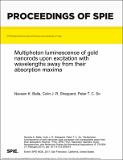Multiphoton luminescence of gold nanorods upon excitation with wavelengths away from their absorption maxima
Author(s)
Balla, Naveen; Sheppard, Colin; So, Peter T. C.
Download79100N.pdf (281.3Kb)
PUBLISHER_POLICY
Publisher Policy
Article is made available in accordance with the publisher's policy and may be subject to US copyright law. Please refer to the publisher's site for terms of use.
Terms of use
Metadata
Show full item recordAbstract
Gold nanoparticles are quite popular as contrast agents for optical microscopy. Their strong linear and nonlinear interaction with light, coupled with their biocompatibility and resistance to photobleaching make them suitable contrasts agents for bioimaging applications. Gold nanorods have been used for in vivo two photon microscopy in small animals [PNAS 102, 15752 (2005)]. Conventional two photon microscopy with gold nanorods involves exciting these particles with femtosecond laser at wavelengths close to their longitudinal plasmon resonance (LPR). Most of the reported works used Ti:Sapphire laser with excitation wavelengths ranging from 780 nm to 850 nm. The rational was to maximize absorption of excitation wavelengths, a fraction of which gives rise to two photon luminescence. This however causes intense heating of the nanorods and unless the excitation powers are kept low, gold nanorods tend to melt [Phys Rev Lett 95, 267405 (2005)]. Another less explored way of getting multiphoton emission from gold nanorods is to excite them at long wavelengths far away from their LPR wavelength [Jour Amer Chem Soc 131, 14186 (2009)]. We are interested in femtosecond lasers operating around 1200 nm wavelengths because of their lower scattering and absorption by tissue and water. Here we compare multiphoton photon luminescence properties of gold nanorods when excited at wavelengths around 800 nm and 1200 nm. Excitation with wavelengths around 1200 nm has certain advantages like lower heating of the particles and hence prolonged durations of imaging. Other advantage is the ability to collect emission in the near infrared regions (NIR) up to 800 nm which is not possible when using excitation wavelengths around 800 nm. These features are good for deep tissue imaging. One disadvantage of this approach is lower luminescence intensity.
Date issued
2011-02Department
Massachusetts Institute of Technology. Computational and Systems Biology Program; Massachusetts Institute of Technology. Department of Biological Engineering; Massachusetts Institute of Technology. Department of Mechanical EngineeringJournal
Biomedical applications
Publisher
SPIE-Intl Soc Optical Eng
Citation
Balla, Naveen K., Colin J. R. Sheppard, and Peter T. C. So. “Multiphoton Luminescence of Gold Nanorods Upon Excitation with Wavelengths Away from Their Absorption Maxima.” Edited by Samuel Achilefu and Ramesh Raghavachari. Reporters, Markers, Dyes, Nanoparticles, and Molecular Probes for Biomedical Applications III (February 10, 2011).
Version: Final published version